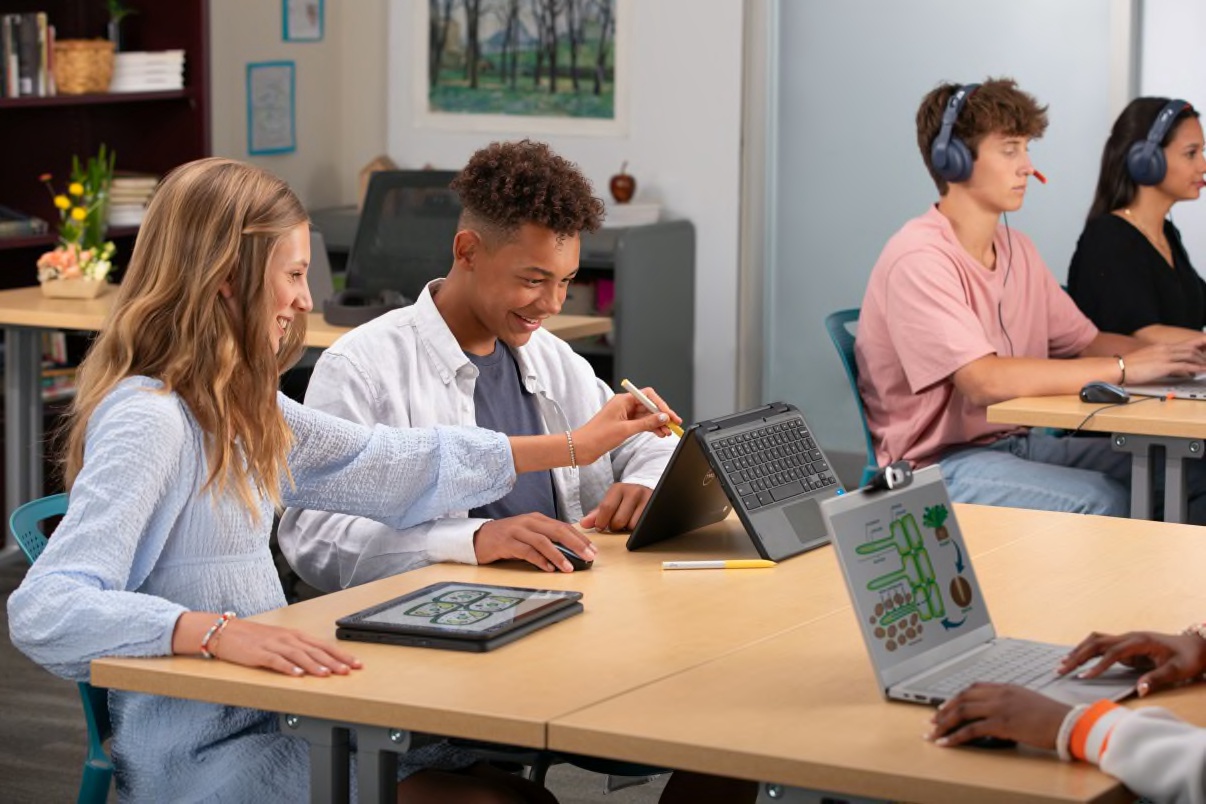Article
Feel Better, Learn Better: How Simple Changes Can Support Student Wellbeing

At any moment, students are dealing with a variety of ergonomics challenges. These can alter the process of learning, with 74% of educators reporting that students’ physical comfort while using educational technology affects their engagement.EdWeek Research Center survey. (2022). Without correct posture and tools, students could also be setting themselves up for lasting health problems like back pain and headaches.Harreby, M., Neergaard, K., Hesselsôe, G., & Kjer, J. (1995). Are radiologic changes in the thoracic and lumbar spine of adolescents risk factors for low back pain in adults?: A 25-year prospective cohort study of 640 school children. Spine, 20(21), 2298-2302. Luckily, simple changes can solve ergonomics challenges at home, in the classroom, and anywhere else learning happens. With a few best practices and well-designed technology, students can stay comfortable, motivated, and focused in even the most dynamic education setting.
Hybrid Learning
In a hybrid learning environment, students are likely taking in a lot of information on screens. Whether they’re on a tablet at home or at the back of the classroom watching their teacher’s every move on an IFP, most K-12 students now get nearly 8 hours of daily screen time. Here are some ways to address the ergonomic challenges a hybrid learning environment presents:
Ergonomic tips:
Rest eyes with the 20-20-20 rule: every 20 minutes, look at something 20 feet away for 20 seconds, to help eye muscles relax.
Adjust font sizes on tablets as needed to avoid eyestrain.
Place screens perpendicular to windows to banish glare and make viewing easier.
Place screens at eye level, especially during longer viewing periods. If students have to tilt their head forward just 10 to 15 degrees to look down at a screen, the strain on their neck and shoulders doubles.Hansraj, Kenneth. (2014). Assessment of stresses in the cervical spine caused by posture and position of the head - https://pubmed.ncbi.nlm.nih.gov/25393825/
Find solutions that can bring screens to the optimal position, and use high-quality cameras to enhance visual lessons.
Solutions that can help:
The Logitech Rugged Combo Keyboard Case has five versatile use modes that can put tablets in the optimal position for comfort depending on where students are. If the tablet is on a desk, using the steeper angle on the stand can lift the screen up and decrease head tilt.
The Logitech Scribe Whiteboard Camera and Logitech Reach Adjustable Content Camera both show non-digital content with outstanding clarity. This can help prevent students from craning their heads forward to see better on their screens or from the back of the classroom.
Individual Learning
Throughout the school day, students often spend time learning individually. For example, some students might open a reading app on their devices and each go through the same lesson at the same time. But high levels of classroom noise may negatively affect them in this case.Shield, B; Connolly, D; Dockrell, J; Cox, T; Mydlarz, C; Conetta, R; (2018) The impact of classroom noise on reading comprehension of secondary school pupils. In: ACOUSTICS 2018. (pp. pp. 236-244). Institute of Acoustics The World Health Organization recommends that classroom noise stay under 35 decibels for optimal learning, but the average classroom is twice as loud. An optimal ergonomic setup ensures students aren’t distracted or uncomfortable when they’re learning by themselves.
Ergonomic tips:
Use headsets to keep students from craning their heads forward to hear audio from devices.
Adjust headset volume to 75 db or less (no more than 60% of maximum volume), to prevent hearing damage.
Solutions that can help:
The Logitech Zone Learn Wired Headset has audio drivers tuned for vocal clarity rather than music, to help students hear instructional content easily. In a performance study of K-6 students, 90% of students said they felt confident in their performance while using the Epic reading app with Zone Learn.Logitech & Epic (2023). 6-week performance study of 54 K-6 students.
- The headset’s ultra-soft comfort layer and micro-articulating ear cups provide a snug, comfortable fit, and the mic designed for vocal pickup allows students to be heard without raising their voices. That means more sustained learning and less classroom noise getting in the way.

Small-Group Learning
It’s common to see students collaborating in the classroom in small groups, whether they’re huddling around one desk or sitting on the floor. Working away from a desk while using laptops or tablets can put hands and wrists in unnatural positions for sustained periods. Younger learners especially may benefit from a keyboard and mouse instead of a trackpad, and using a stylus instead of fingers to write on a tablet screen may make writing easier.Logitech. (2021). Ergonomics Lab study.
Ergonomic Tips:
Adjust the technology to the activity. For example, a tablet flat on the table may be appropriate for sketching or annotating as a group, but not for watching videos or listening to audio content.
Try to encourage students to place tablets or laptops on a table or desk to collaborate, rather than in the lap, to avoid wrist strain.
- Use companion tools like styluses and mice whenever necessary to improve posture and increase efficiency.
Solutions that can help:
The Logitech Pen USI Stylus for ChromebookTM encourages a natural writing experience on tablets with dynamic line widths and precision down to the pixel. Plus, it's designed to be the right size, weight, and shape to support different hand sizes and different levels of motor skills development. 89% of students surveyed from ages 4 to 17 found Logitech Pen comfortable to use.
- The Logitech MK120 Corded Keyboard and Mouse Combo can increase comfort and stop fatigue as students collaborate on projects. The full-size keyboard with adjustable legs and ergonomically-curved spacebar encourage good wrist posture while making typing and navigating easy. The curved shape of the MK120 mouse supports the palm for both righties and lefties, preventing the wrist and forearm discomfort that students might experience with trackpads and enabling maximum focus.
Ergonomics is an often overlooked but very important part of effective learning. With edtech, the goal is to provide solutions that are flexible enough to allow students to learn however they prefer, but thoughtfully designed to provide ergonomic support throughout the school day, no matter the situation. Whether they’re sprawled on the floor or at home sitting on a kitchen stool, students deserve tools that'll stay out of their way and help them learn with comfort, ease, and excitement.
For more tips, see our Practical Ergonomics Guide for Education.
Let’s Talk
Learn more about how Logitech can help you shape the future of education.
Contact Sales
THANK YOU FOR CONTACTING US
A product expert will reach out to you shortly.